The La Sportiva TX3 is our top pick for best approach shoe. It fits well and has a great balance of hiking comfort and climbing ability. It’s super reliable on variable ground and we found we were able to climb easy rock with confidence due to its great outsole, edge and fit. It’s also great and lightweight for carrying on long climbs but this doesn’t significantly sacrifice its durability.
Our step-up pick is the Boulder X, also by La Sportiva. It is super durable and burly, built to handle tough approaches, but we found it also climbs well. It has a very sticky sole and great edge which gives us confidence on easy climbing. The Boulder X has a unique lacing system which made us feel secure, no matter what shape of foot we have.
Our budget-pick is the Evolv Cruzer Psyche. It also does a great job of balancing hiking and climbing ability, but in a more minimalist way. It’s very low-profile and comfortable, and is quick and easy to slip on and off for cragging days. It has a slightly more climbing-oriented sole, which we found was great for approaches that involved lots of rock and it was one of the best for doing easy slab pitches in our approach shoes.
| Rubber | Closure | Upper | Waterproof | Weight per Shoe | Climbing vs. Hiking Focus | |
| TX3 | Vibram Mega-Grip | Laces | Synthetic | GTX Available | 180g | Good balance |
| Boulder X | Vibram Idro-Grip | “Mythos” lacing system | Leather | If waxed | 481g | Good balance |
| Cruzer Psyche | Evolv TRAX | Laces and foldable heel | Canvas | No | 283g | Climbing |
| Guide Tennie | Five Ten Stealth | Laces | Leather | If waxed | 373g | Climbing |
| TX2 | Vibram Mega-Grip | Laces | Synthetic | No | 140g | Good balance |
| Zen | Vibram Spyder II | Laces | Suede | If waxed | 440g | Hiking |
| Crux | Vibram Mega-Grip | Laces | Suede / Synthetic | If waxed | 383g | Good balance |
| Acrux SL | Vibram Mega-Grip | Laces | Synthetic | GTX Available | 300g | Climbing |
| Mountain Trainer GTX | Vibram Mtn Trainer Evo | Laces | Leather / Synthetic | GTX | 540g | Hiking |
| TX4 Mid GTX | Vibram Mega-Grip | Laces | Suede | GTX | 485g | Hiking |
| Arakys | Vibram Mega-Grip | One-strap and foldable heel | Synthetic | No | 270g | Good balance |
A Little Background
When you think about climbing, what key pieces of gear come to mind? Your harness is pretty important, and so are your climbing shoes. Rack up with some quickdraws, cams and wires; grab your rope, chalk bag and helmet, chuck them in your backpack. However, there’s another item that sometimes takes the back seat, and we’re going to shed some light on it.
Often forgotten in the discussion around climbing gear, the humble approach shoe can actually be a key player in your best climbing routes, days, and trips. It gets you from the car (or tent) to the climb, whether that’s a five minute walk, a multi-day hike, through snow or streams, or via hundreds of feet of rock scrambling.
We’re going to give it the respect it deserves. Here, you’ll find important information on the key factors in what makes up the best models, plus our picks of the best in each sub-category. We’ll also give you some handy tips on making the best choice for yourself, as well as answering some common questions.
 |
| Approach shoes are a critical part of how we achieve our climbing goals. |
How We Picked
Ideally, an approach shoe is a happy medium between a climbing shoe, hiking boot, and sometimes also a mountain boot. To achieve this complicated task, there are several important features that make up an what we’re looking for.
More focus on one area for a particular model will result in a shoe that is best suited to either the climbing or the hiking end of the spectrum, however we looked at everything, tested many models in different situations, and weighed up the factors accordingly. Here is what we were looking at:
- Rubber
- Outsole
- Edge and Rand
- Stiffness
- Closure
- Upper
- Waterproofing
- Weight
- Climbing performance
- Hiking comfort
Now, let’s break down each point and take a look at what makes it important when choosing the best models.
Rubber
The rubber on an approach shoe should be sticky enough to instill confidence and climb well when scrambling and on easy fifth class terrain, but it should also be durable enough for long hikes and to give an acceptable lifetime to the shoe. This often means compromising somewhere along the way, however brands such as FiveTen (Adidas) and Vibram have made it their business to come up with top-of-the-line compounds that excel in both aspects.
Shoe companies recognise that making the best rubber is difficult, so they usually feature an outsole and rand from a different, specialist, company (e.g. a Scarpa shoe with a Vibram sole). This isn’t always the case, though, and shoes that use their own proprietary rubber that have made our shortlist have done a very good job.
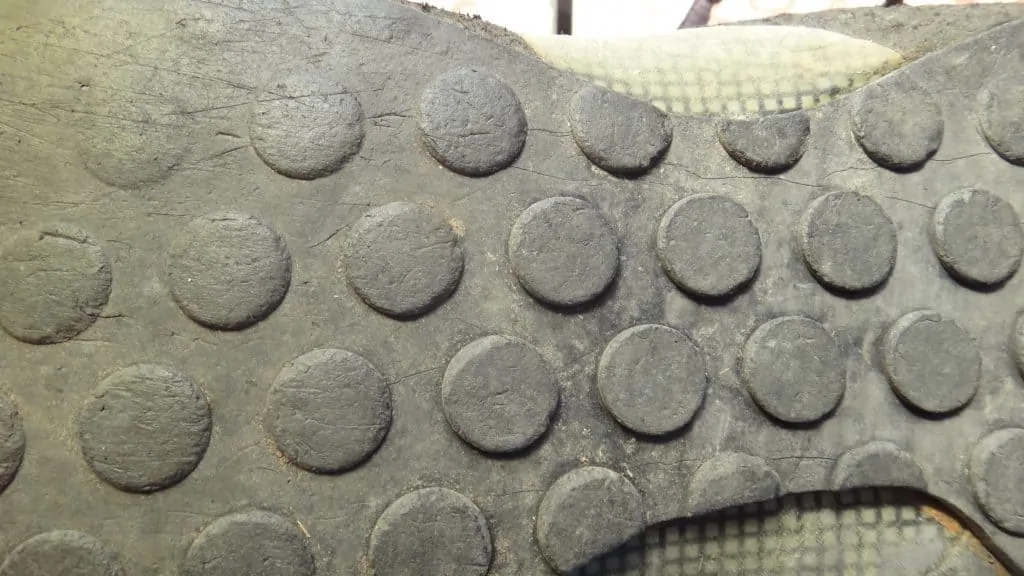 |
| Even after a long life, this Five Ten rubber is still super sticky.
Source: self-taken |
Outsole
In addition to the type of rubber on the sole, the pattern and distribution of rubber types also plays a big part in an approach shoe’s performance.
Common on the outsole of most approach shoes is a smooth, flat section under the toes. This is different from a general hiking shoe sole (which has lugs from front to back) because climbers may need to use their toes in a technical climbing application when to the climb. Sometimes this flat section also extends down the outside edge of the sole, for greater edging capacity.
The midsole usually has a pattern of lugs that range from being either very deep and chunky (more focus on hiking) or very smooth and shallow (more focus on rock scrambling). Some models actually use a different rubber compound in the midsole from that found in the toe area — with the idea that stickier, less durable rubber may be needed for climbing applications in the toe area, and harder, more durable rubber is useful for longevity of the lugs used in hiking.
Another important feature of the sole is the downhill braking ability. This is usually achieved with an edge just before the heel area which catches the dirt / mud / scree and prevents the whole foot from sliding forwards, downhill, on these rough and slippery surfaces.
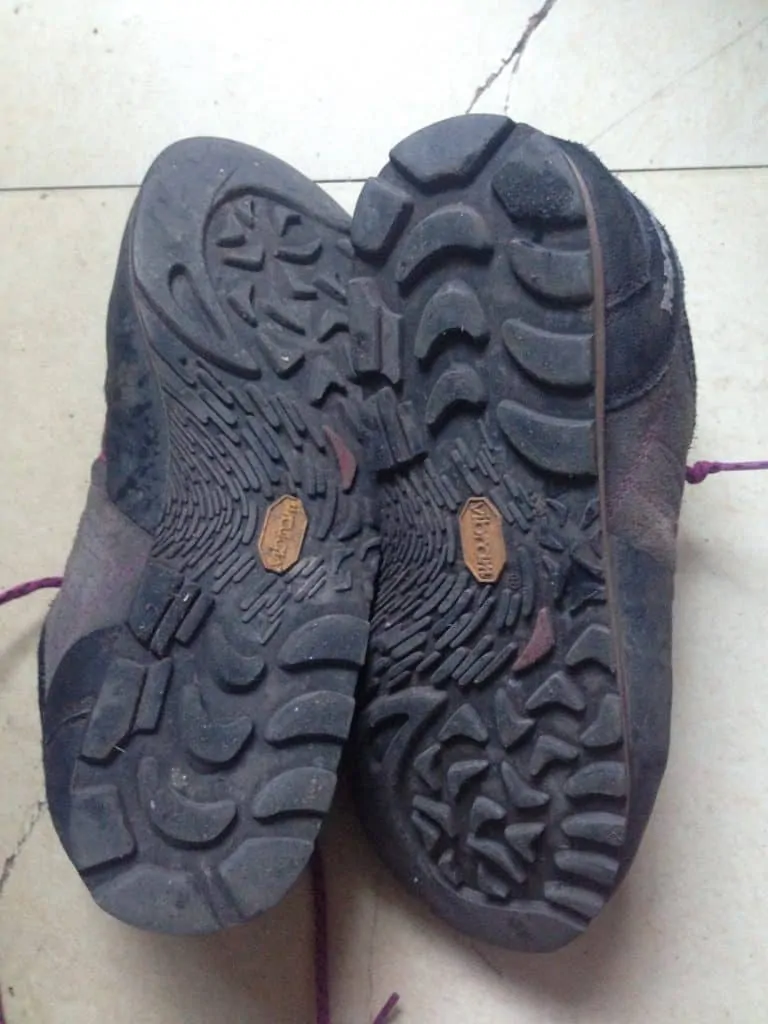 |
| This outsole has a combination of lug types in different places for best traction and climbing ability. |
Edge and Rand
Perhaps the biggest, most obvious difference between an approach shoe and a regular running shoe or lightweight hiker is its edge and rand.
Having a good edge to your shoe is important when climbing — even on easy terrain. It needs to be able to direct your body weight onto small holds and smear onto slabs without separating from the sole. Different brands look at edges in different ways: Fiveten shoes tend to have a rounder edge that smears surface area onto the hold, whereas La Sportiva tends to have a sharper edge that offers precision placement.
Rand is the extra bit of rubber extending up from the sole, over the toes, and often also around the sides of the forefoot. The best rand is one that doesn’t instantly separate from the upper or the sole, so durability is a big factor here. We’ve combined rand with edge in our testing because they are so closely linked, literally. The rand also plays a big part in your contact to the rock when climbing cracks or pushing your toes against the wall while aid climbing.
 |
| This model has a protective rand for scrambling and climbing, and a defined edge for use on rock. |
Stiffness
Here is another category where we try to find a happy medium. We need a soft shoe for sensitivity while climbing, however we need a stiff shoe for support on long approaches and tough terrain underfoot. Stiff for support and durability, but not too stiff, or else our arches suffer.
Generally, an approach shoe is stiffer than a climbing shoe but more sensitive than a heavy duty hiking boot. We looked for a good balance, here.
Closure
Laces on approach shoes usually extend further down the foot than on a regular running or hiking shoe — almost to the toes. This is so we can get a more precise, and closer fit, needed for climbing purposes so that we can feel exactly where our toes are on the rock.
Most of these shoes have laces, and some even extend around the back of the heel so you can really get a close fit in the ankle department. Some laces are coated for durability, some are round and abrasion-resistant, and some are plain and flat. Some shoes don’t have laces — a couple of models instead have a velcro system that is quick and easy to use but lacks the precise fit that you can get with laces.
We looked for a closure system that provided a good, secure fit, that was durable and robust, and which stayed put once done up.
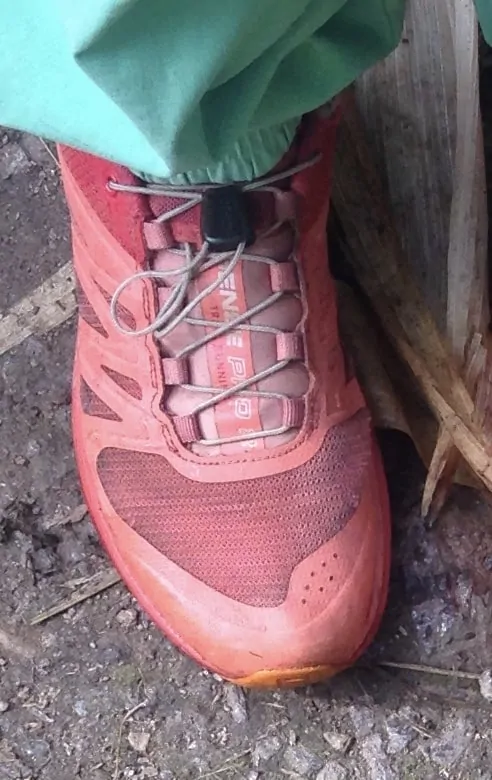 |
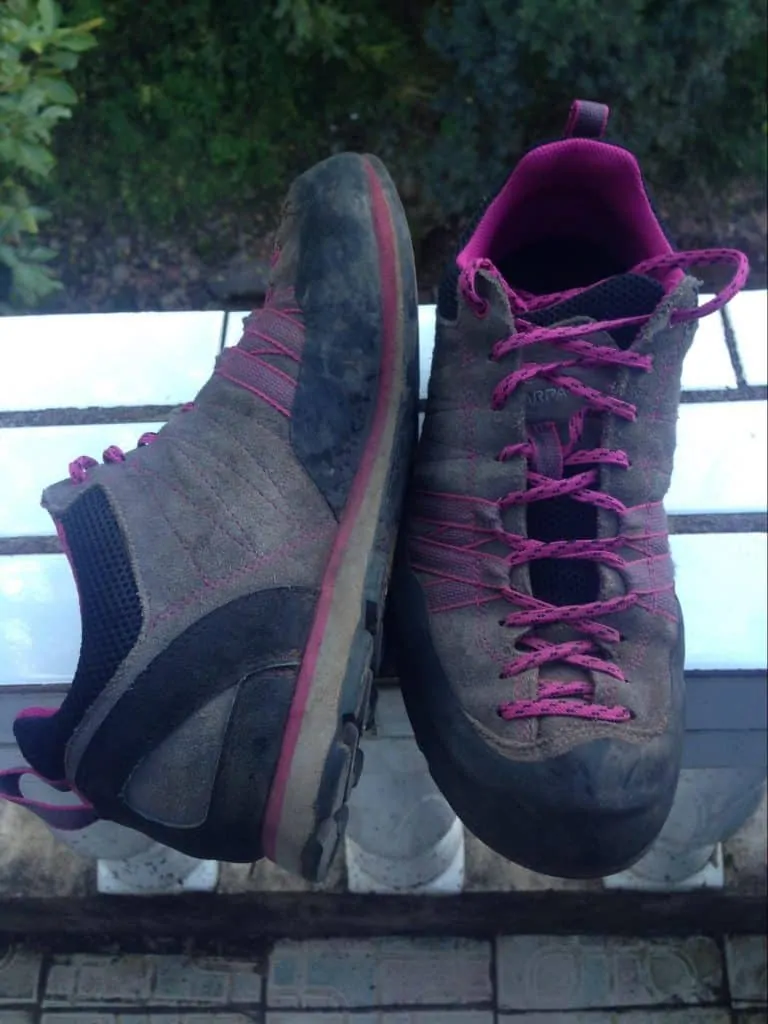 |
| Notice how far the laces extend towards the toe of the approach shoe (right) versus the running shoe (left).
Source: self-taken |
|
Upper
Uppers on approach shoes vary greatly. Common materials are leather/suede, synthetic leather, synthetic breathable mesh, and canvas. It is difficult to say which is best, as each have their pros and cons.
Leather is durable, breathable and waterproof-able. However, it is heavy and stretches when worn in.
Synthetic leather has the same aesthetic appeal as leather, can be waterproofed, and is fairly durable. It doesn’t stretch like leather when worn in, however it is still relatively heavy.
Synthetic mesh provides great ventilation, necessary on some hot approaches, and it is fairly lightweight. However, it is not so durable and wears out quicker than some heavier materials.
Canvas is relatively tough and durable, as well as relatively lightweight. It doesn’t usually breathe as well as mesh.
Often, companies use a combination of materials for different parts of the upper, in order to get the best of several worlds. We considered the appropriateness of the material to the focus of the shoe (i.e. more focus on scrambling vs. hiking vs. aid climbing).
Waterproofing
Whether an approach shoe actually needs to be waterproof, is up for debate. In some cases it is particularly useful, e.g. descending through snow and rock, or small streams. However, in most cases, you won’t need your shoes to be waterproof.
Having said that, we still looked at the effective waterproofing of shoes that are, and ranked the best ones accordingly.
Weight
Aside from the obvious — weight on your feet while walking — the weight of your approach shoes is important even when you’re not wearing them.
When multi-pitch climbing, if walking off is your descent plan, approach shoes will often be either clipped to the back of your harness or in a small backpack. The heavier your shoes, the more extra weight you’ll have dragging down your climbing performance and making those pitches seem even harder.
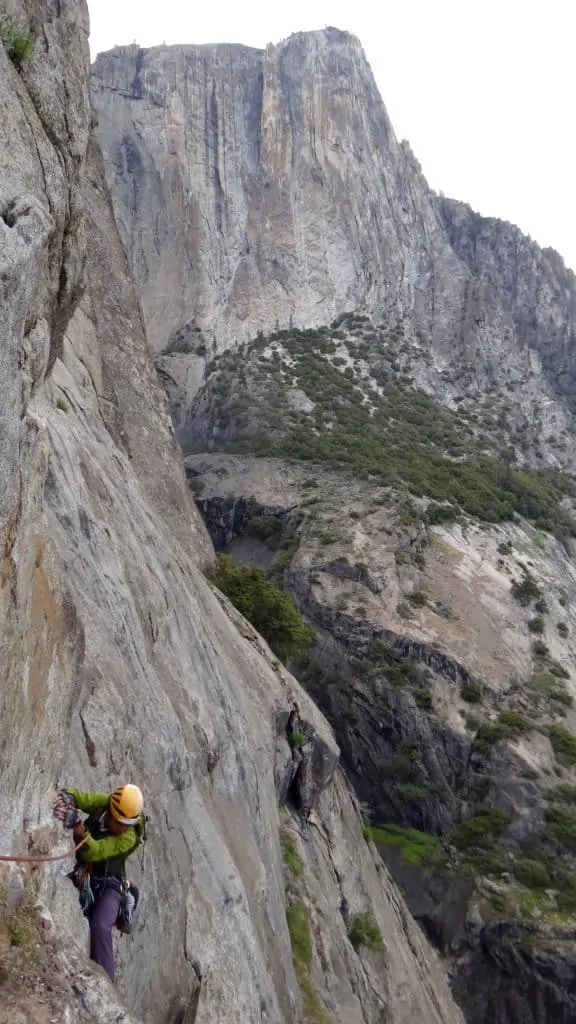 |
| The climber here is carrying his approach shoes to use for the descent from this long multi-pitch. It’s important that they are light and non-bulky. |
Climbing performance
Often, you’ll need to do some moderate scrambling before you rack up and put your climbing shoes on. Sometimes this even extends to low fifth class terrain, where you might have sections of technical climbing broken by sections of scrambling and hiking. In this situation you really need to be able to trust the climbing ability of your approach shoes.
Key points we looked at in climbing performance were:
Edging — the ability to step on tiny edges and stick there.
Smearing — using the pressure of rubber against rock to make the bottom of your toes stick to slabby rock.
Sensitivity — being able to feel the rock and holds through the shoes.
 |
| Getting to this climb requires some slab climbing performance from the approach shoes. |
Hiking comfort
We spend hours upon hours walking to and from climbs in our approach shoes, and we often have heavy loads on our backs. To this end, they should be comfortable and provide adequate support.
The shape and fit of our approach shoes is a key factor in their comfort. Shoes that constricted our toes too much or were too sloppy in the heel, for example, didn’t do so well. Another important piece of the comfort puzzle is support underfoot. A decent sole with some shock absorbing properties goes a long way to keeping our feet feeling fresh for the climb.
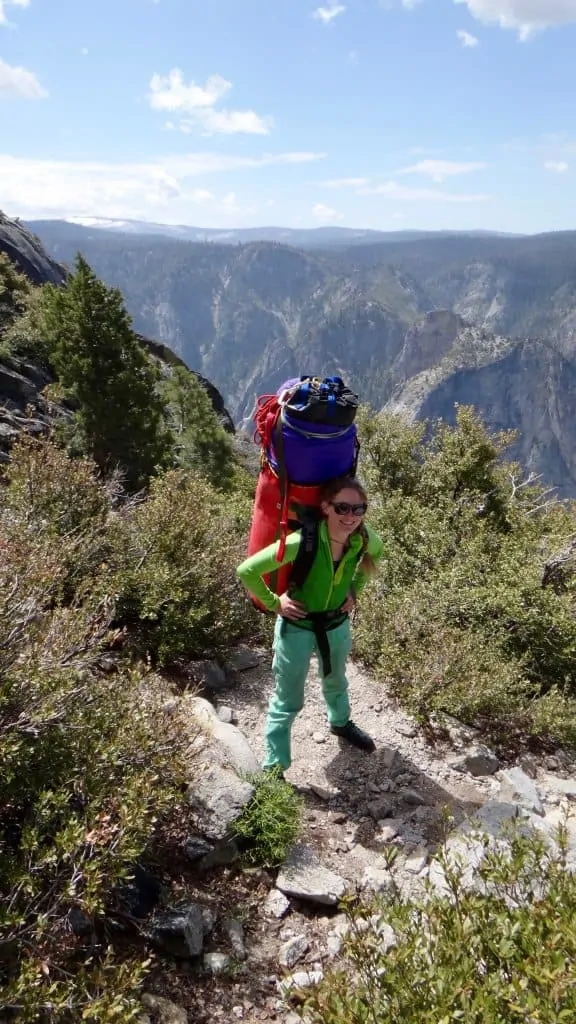 |
| It’s important to have comfortable feet when carrying such big loads to or from your climb. |
Top Pick
Our best all-around approach shoe is the La Sportiva TX3 (and the women’s version). With a comfortable, yet close fit, you feel like you could almost go for a run in these shoes, and yet they provide all the great support and features that an approach shoe needs.
The TX3 are stiff for stability on long hikes and technical terrain, and La Sportiva have opted for the tried-and-true performance of a Vibram rubber sole (specifically, their “MegaGrip Traverse” outsole). Sticky rubber helps with traction on rock when hiking, scrambling and climbing; there is a heel braking feature for technical descents; and a smooth under-toe area, great for edging and smearing on technical rock.
The rand — which wraps right around the shoe — helps with torsional rigidity as well as crack climbing. It also helps with abrasion resistance when hiking on rough terrain such as scree and boulders.
The synthetic upper contributes to the low weight of this shoe. This, along with the clip loop on the heel, makes it great for carrying on a climb as a descent shoe. You can also get a waterproof version which has a Gore Tex liner in the upper.
The TX3 is a do-it-all approach shoe. It is great for short, comfortable walks and carrying up and over a climb. You could just as easily take it on a multi-day hike and be comfortable, and it would still climb fairly well when you encounter technical terrain. You could wear it on snowy approaches or descents and the waterproof version would be tough enough to do the job. It is also stiff enough to accept a lightweight crampon, if need be.
Flaws But Not Dealbreakers
The TX3 is not the most durable shoe on the market. This is because of the synthetic mesh upper. However, it is also not the least durable, and we were happy to trade some durability for comfort (breathability) and to shed some weight.
Step-Up Pick
Our next best pick, also by La Sportiva, is the Boulder X (and women’s version). It has been around for quite some time now and has remained a solid choice for new and seasoned climbers alike.
With a super sticky “Idro-Grip” Vibram sole, the Boulder X is reliable on tricky, mixed hiking / scrambling terrain, as well as on rock. The heel-brake is effective on mud and loose rock, and the smooth under-toe helps make those easy climbing moves possible without switching to rock shoes.
This shoe is very stiff and has extra cushioning underfoot, making it a great choice for long approaches and / or rough terrain (it could also take a lightweight crampon if needed). The lacing system is borrowed from La Sportiva’s Mythos climbing shoe — the laces continue around the back of the ankle so you can adjust fit around the heel as well as across the top.
A leather upper makes the Boulder X very durable, and you can wax it to maintain waterproofness. Just remember that it will stretch slightly from its initial fit once you’ve worn it in.
The Boulder X is a solid, burly approach shoe that you can rely on for gnarly hikes, difficult scrambling and easy climbing.
Budget Pick
Our best budget pick is the Evolv Cruzer Psyche (and women’s version). It has all the basic features of a good approach shoe but at a much more affordable price.
This is a very simplistic design, comfortable and with a streamlined look. The upper is cotton canvas, lined on the inside with microfiber memory foam: durable and comfortable. You can even collapse the heel for easy on-off wear. The rand covers the toe box to provide extra durability.
The Cruzer’s sole is made with Evolv’s own TRAX rubber, known for being sticky. There is the expected flat patch under the toes to provide good smearing ability when climbing, however no heel braking feature. This actually makes the Cruzers very good at slab climbing: they excel at high-friction, low angle rock slab scrambling and climbing.
If you’re after a basic, comfortable, yet affordable approach shoe, then the Cruzer is a good option. It even has a variety of colour options.
Best Approach Shoes For Climbing
Our best pick for approach shoes that can climb technical rock well are the Five Ten Guide Tennie (and the women’s ones). These are another tried-and-tested model that continues to impress climbers with their all-around consistency, and exceptional climbing ability.
Five Ten’s famous Stealth C4 rubber is one of the best sticky rubbers on the climbing shoe market. It’s featured on the Guide Tennies in a dotted pattern — great for increased contact with rock (and therefore friction) when scrambling and climbing. There is the usual flat section under the toes to enhance smearing ability, and the toe rand meets the sole nicely with a clean edge.
The Guide Tennies are also comfortable and durable, with a combination leather and synthetic upper and molded midsole.
If you need an approach shoe that you can trust for low fifth-class terrain, but that will also be comfortable on the approach and descent, the Guide Tennies are a great option.
Best Approach Shoes For Carrying On A Multi-Pitch
Our best pick for approach shoes that we’d like to carry up and over a climb are the La Sportiva TX2 (and women’s version). Weight is most important here, and the TX2 is basically a slimmed-down version of the TX3 (see our Top Pick, above).
It has a super-breathable mesh upper that saves on weight and also drains water quickly when wet. Extra weight savings are made by cutting out the rand at the middle of the foot, however it still wraps around the toe-box and heel cup for added durability.
The TX2 sports a Vibram “Mega-Grip” sole — super sticky and reliable rubber. The lugs are low-profile circles (similar to the Guide Tennie sole) for great contact with rock, and we also find the usual flat under-toe patch for smearing.
One of the best features of the TX2 is the “C2 Combo Cord”. This is essentially a built-in elastic cord which pulls out from the heel and wraps around the whole pair of shoes (one at each end) to keep them together and compact while hanging on your harness.
Best Approach Shoes For Long Hikes
For long approaches, our best choice is the Scarpa Zen (women’s version here). On the climbing versus hiking spectrum, the Zen is closer to the hiking end, however it can still hold its own on easy scrambling.
The sole is a Vibram “Spyder II” — sticky and with big lugs which handle varied terrain when hiking. It looks more like the sole you’d find on a hiking boot than some more climbing-oriented approach shoes (like the Five Ten Guide Tennie or Scarpa Crux), however it still features a small patch of smooth rubber beneath the toes. The burly rubber rand covers the whole toe box for best protection when scrambling through boulders or scree.
This is a super comfortable shoe, with an injected EVA midsole for underfoot support during long hikes with heavy loads. The upper is durable leather which will soften with time, however won’t stretch too much thanks to the stitching support on the sides.
Best Approach Shoes For Wide Feet
Many climbers with wide feet simply don’t fit some of our other top picks. If this is you, don’t worry — the Scarpa Crux (women’s version here) is not just our best pick for wide feet; it’s one of our best picks, regardless.
Another great all-arounder, the Crux is good at both hiking and climbing, while also being durable, but not excessively heavy.
The sole is a Vibram “Vertical Approach” with Megagrip rubber — known for being very sticky. It’s got low profile lugs which are bigger on the heel than the front, and there is a mild heel braking feature to help with downhill traction. Under the toes is a smooth, smearing platform, which curves upwards with the rocker of the shoe to finish in a nice, sharp edge.
The rubber rand covers the toe box and extends halfway down the foot, which gives the Crux great protection and durability. It also works well for foot jams when climbing. Speaking of climbing, the Crux is one of our favourites: it’s burly, sticky, low profile and sensitive enough to be reliable on those fourth and fifth-class approaches.
With a suede upper, reinforced with side stitching, the Crux is a very durable shoe that won’t stretch too much after buying. The laces extend all the way to the toe box so you can get a tight, comfortable and very secure fit — even for those of us with wider feet.
Best Approach Shoes For Narrow Feet
The Arc’teryx Acrux SL (and the women’s version) is another one of our best picks. However, it doesn’t fit everyone: it’s best for climbers with feet on the narrower side.
Arc’teryx is known for being very innovative and very high quality, and the Acrux SL is no exception. The upper is made of a single, seamless piece of synthetic material, which makes it very comfortable as well as durable. Another innovation here, is the tongue-less construction; instead, there is a stretchy piece of lining across the top of the foot (under the laces) which is joined to the rest of the upper. There are pull tabs on both the front and back of the opening to help slip your foot in, and once its in, it’s one of the best-fitting models I’ve ever used.
The sole is made with Vibram MegaGrip rubber (super sticky) which is divided into three different sections. The forefoot is smooth, apart from some circular outlines cut into it (smooth is best for climbing ability), the midsole has shallow circular lugs for grip, and the heel has deeper lugs, like a hiking shoe, for grip on variable surfaces. There is a shallow heel braking feature, too, which works well in most terrain.
While the rand, at first, looks pretty low-profile and minimalist, it actually performs very well. I have used the waterproof version of these shoes for a couple of years and every time I emerge from a gnarly, granite boulder field or finish up a desert rock trip I am surprised that the rand is still perfectly well attached to both the upper and the sole. I have climbed cracks up to 5.10 on El Cap in these and they are still very much in one piece!
Last, but not least, they are called SL for a reason. SL stands for “super light” — they are, in fact, some of the lightest shoes on our shortlist, and I have not hesitated to take them on many a long multi-pitch.
Best Waterproof Approach Shoes
Our best pick for a waterproof shoe is the Salewa Mountain Trainer GTX (women’s version here). This one is marketed as an “alpine approach shoe”, and it surely does that job!
Approaching or descending through snow can be a problem with a lot of models which focus on being super lightweight and breathable, but many of which are not the best at keeping our feet dry. The Mountain Trainer GTX fills this gap. It’s nimble enough to scramble in while being tough enough to protect our feet in the mountains, and it’s not heavy or bulky like a mountaineering boot.
The upper is a burly leather and synthetic combo with a Gore Tex lining which does a great job of keeping water (and snow) out. The rand wraps the whole way around the foot, which gives us confidence that this shoe will hold up to a lot of abuse from harsh mountain environments. You can make sure you get the best fit by utilising the lacing system which extends all the way to the toe box.
On the bottom, we have another great Vibram sole with sticky rubber. The lugs here are deeper and more spaced — like a hiking shoe sole — however we still have a smooth smearing platform under the toes and a great toe edge for climbing. There is a decent heel braking feature, and even a special groove in the midsole for via ferrata rungs, if that’s something you’ll be doing in these shoes.
Best Mid-Height Approach Shoes
Our best pick for mid-height shoes goes to the La Sportiva TX4 Mid GTX. They have some features in common with our best pick, as well as some extras which make them a great approach shoe for those long, burly hikes with heavy packs.
The TX4 shares the same sole as the TX3 (our best pick) — sticky vibram rubber with a combination of big and small lugs for great hiking ability as well as ability to stick to rock. The smearing platform is the same and we still have a great toe edge for climbing. The rand also encloses the entire toe box and wraps around the whole shoe, just like the TX3, for great protection during gnarly scrambles as well as good climbing ability in cracks.
One of the main differences between the two models is in the upper: the TX4 is made of durable leather, with a Gore Tex membrane to keep the water out (the TX3 is lightweight, synthetic). We found this to be an excellent feature which was needed in a mid-height shoe, if it was to be used in tough terrain and over long distances — and to last for the next trip!
The fit is very comfortable, with a roomy enough toe box that we weren’t sore after a long hike, and some great ankle support. The mid-height ankle is actually quite a bit lower at the back and we found this to be a great feature when walking down steep dirt and rock; the back of the shoe didn’t cause the annoying chafing that other, higher-ankle models did.
Overall, the TX4 Mid GTX packs in a lot of the best features that you’d expect in a burly, mid-height approach shoe, and it manages to do it without being overly bulky or heavy. In fact, there is a clipping loop on the heel (like most lightweight approach shoes have) suggesting you might even take these on your harness up a climb.
Best Approach Shoes For Cragging
When it comes to cragging, our best pick was easily the Arc’teryx Arakys (and the women’s Arakys). Ease of use and reliability is important here, and Arc’teryx have certainly created something that fits the bill.
The first thing we noticed with the Arakys is the different closure system from all the other models on our shortlist. Instead of laces, we have one strap (zigzagged down the whole foot) and buckle which you can operate with one hand. It’s very quick and easy, and for short approaches and cragging days where you’re constantly putting your shoes on and off, this is great.
The other obvious feature that we loved for cragging and bouldering is the collapsable heel. You’ve probably done this to other shoes before — folded the heel into the shoe and worn it as a slipper — but also probably damaged expensive shoes in the process. The Arakys are actually designed to do this, without shortening the lifespan of the shoe.
The basics are still covered here, too. Durability is looked after with a ripstop nylon upper. The Vibram sole is made with sticky MegaGrip rubber, and the lug pattern is the same as the Acrux SL (our best pick for narrow feet, above). We found that we could rely on the Arakys to hike and climb just ast well as the Acrux SL on the approach, and then when it came to hanging out at the crag, it transformed into an easy on-off slipper.
Choosing The Best Approach Shoes For You
Before you head out to buy your next pair of approach shoes, you need to decide which features are most important for your needs.
Is most of your climbing done at easy-approach crags or do you prefer to climb long routes with more involved approaches? Maybe you walk for days to get to your climbing destination, or maybe you drive right up to it. Maybe it’s important for you to have something you can easily slip on and off, or maybe it’s more important to have something that does best on long hikes and provides good comfort.
Do your approaches tend to involve scrambling through talus for hours and climbing a couple of “approach pitches”, or do you usually stick to well-traveled trails? Maybe you need something that can climb rock well, or maybe having more of a hiking focussed outsole suits your needs. Do you climb a lot of alpine rock where you need to carry waterproof shoes with you for the descent, or do you prefer to climb in hot places where breathability is more important?
If you do a bit of everything — a variety of climbing and approaches — then our best pick, the La Sportiva TX3 would be a great choice. If you have particularly wide or narrow feet, then see our best picks for those categories. Otherwise, we have also outlined the best models for more specific approach needs, above.
The Competition
There are so many options out there for approach shoes that it was hard to narrow down the selection to just the best ones on our shortlist. We left out those that were mainly hiking shoes / boots and focussed on those that obviously also had some kind of a balance with rock climbing ability. We also left out those that were much less durable or comfortable.
Other Frequently Asked Questions
Q: Can’t I just use regular runners to get to the climb?
A: You can, but there are situations where runners are impractical and the best outdoor gear would do much better for you. When the approach is long, off-trail, technical trail, over boulders or scree, steep dirt or grass, you’ll want a more technical and sticky outsole than what regular runners can offer. You’ll also want more durability in the upper and more protection around the toes than what running shoes have. If the approach involves scrambling over rock or easy rock climbing then you’ll also want the security that sticky rubber provides, as well as the precise fit you can get with approach shoes but not with runners.
Q: If approach shoes can climb so well, why do I need separate climbing shoes?
A: Approach shoes can climb well to an extent — you’ll be fine up to a certain grade and on certain styles with approach shoes. Like most things, there is a compromise: here, between climbing and hiking ability. Excellent climbing ability is sacrificed for good hiking ability. Having said this, if your climb is an easy grade for you (for example, an easy alpine ridge scramble), you may find that your approach shoes will also suffice for the climb. Many mountain guides use their approach shoes to guide easy (for them) climbs.
 |
| Steep grass like this requires technical footwewear for good grip and fit. |
Wrapping It Up
All-in-all, the approach shoe is an important piece of kit when you’re going climbing. It has many features specific to hiking as well as climbing and it’s good to know how to weight these up against your own needs and objectives. Things like the edge, rand, outsole, fit, durability, rubber and weight all make a difference in the end result, and we have broken down these points so you can check them out, above, and find the best fit for your needs.
Whether you’re camping out on an extended climbing trip, planning your next big climbing expedition, or just heading out to the local crag, there is an approach shoe that will fit your needs.